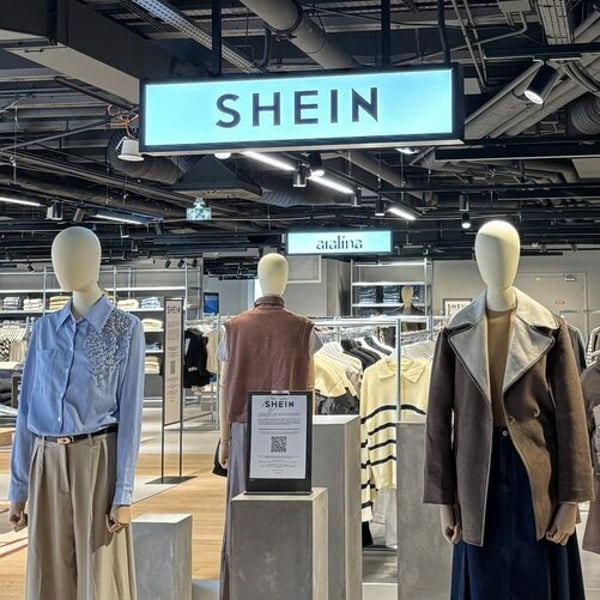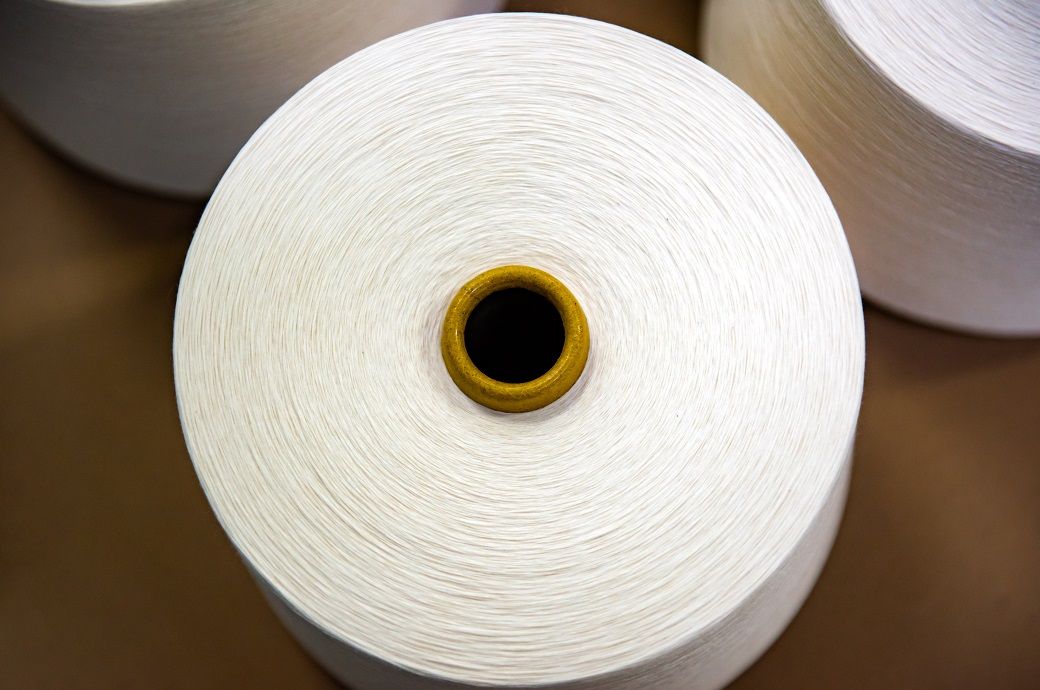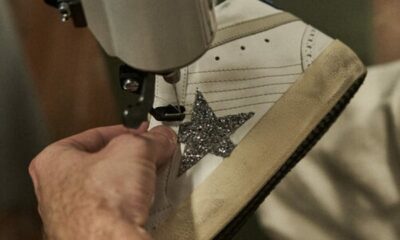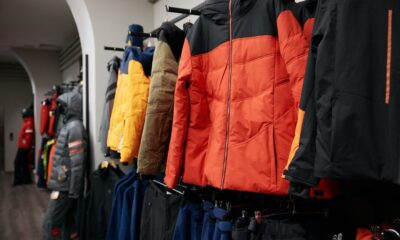Fashion
Shein sets up shop at Paris’ BHV: What’s on offer and what’s the concept?

Published
November 5, 2025
Wednesday, November 5, at 1pm. The opening of the Shein boutique at BHV Marais drew a large crowd. For several hours, the first customers waited in a long queue at the foot of the Parisian department store to enter the Chinese brand’s first permanent bricks-and-mortar store. On the other side of the street, dozens of demonstrators, local elected officials and union representatives voiced their disapproval at the much-maligned brand setting up shop.
The protest was largely ignored by the many enthusiastic customers celebrating the event, which began on the sixth floor, in the area dedicated to Shein, with an introductory speech followed by a countdown marking the official opening of the doors. Once the symbolic ribbon had been cut, Frédéric Merlin, managing director of BHV and Société des Grands Magasins (SGM), led the first customers through the store, presenting the different areas before concluding the tour at the tills. Facing numerous journalists from around the world, he said he was “very pleasantly surprised to see the enthusiasm for this opening, which is attracting new customers as well as regular BHV customers.”
The event quickly took on the feel of mass consumption, somewhere between curiosity and a shopping frenzy.
The new 1,000-square-metre space, mainly dedicated to womenswear, occupies a large open area segmented into several zones. Shein does not, however, occupy the entire level: a small part of the sixth floor is still devoted to Christmas décor. But there was certainly no party atmosphere in that area on Wednesday.
There is no major retail innovation in the layout. But the range is clearly compartmentalised: casualwear, sportswear, formalwear and accessories. Around 80% of the items are aimed at a female clientele across different profiles, the remainder forming a more limited menswear offer: zip-up jumpers, cargo trousers and other casual basics.
Clothes are presented on simple shelves fixed along the walls, while in the centre more classic rails display the vast majority of pieces on hangers. The overall look is restrained and clearly easy to reconfigure, but the staging is elevated by carefully chosen furnishings: marble, stone or glass tables add a chic touch, complemented by tempered-steel details.
The spaces are structured by zone, identified by Shein sub-brands such as Aralina, Motf, Dazy and Anewsta, offering a clear read of the range and a more premium visual impression. Each has a staging area with mannequins and a product presentation space. A few comfortable armchairs dotted around allow visitors to take a break, a sign that the brand also wanted to enhance the visitor experience.

On price, the promise of accessibility is clear: from a sports bra at €7.49 to a Dazy down jacket at €127.49, the store’s most expensive item. Yet although around 6,000 items have been selected, there is no sign of the €2 or €3 pieces that also helped drive the brand’s online success. Each in-store product carries a QR code on its label linking to the product page on the brand’s website, where prices are sometimes much lower online.
Another of Shein’s digital promises that does not necessarily carry over into the physical world is its offer for all body types. Sizes range from XS to XL, a more limited choice than online.
It is worth noting that the store features few screens, contrary to what you might expect from an e-commerce player. Here, Shein is asserting a physical presence and the classic conventions of apparel retail.
Finally, the opening did not escape controversy: beyond the gatherings in front of the building and the significant police presence around the event, protesters entered the Shein area to brandish placards and shout slogans against the Chinese retailer.
Despite this, inside the crowds were out in force. Bags filled, rails emptied. Shein has made a successful entry into the physical world, with a concept calibrated to appeal to a broad audience.
But what about the other floors of the department store? Merlin said he expected very low footfall on Wednesday. To try to generate traffic, the department store promised a voucher equivalent to the amount of Shein purchases made on Wednesday. Given the lacklustre traffic on the other seven levels, the pulling power of Shein as a locomotive for the whole of BHV remains to be demonstrated.
With Olivier Guyot
This article is an automatic translation.
Click here to read the original article.
Copyright © 2025 FashionNetwork.com All rights reserved.
Fashion
BRC calls for retailer collaboration on net zero emissions

Its new UK Retail 2025 Net Zero Stocktake report uses improved real-world data to assess industry progress, challenges and priorities on the path to net zero.
Using improved data quality and broader coverage, the report provides a clearer picture of industry emissions. The accompanying survey shows strong progress, with 91 per cent of retailers having established and publicly reported GHG baselines, four in five fleet drivers trained in fuel efficiency programmes, and 90 per cent of new retail buildings using LED lighting.
The British Retail Consortium (BRC) has urged retailers to strengthen collaboration across the value chain to tackle scope 3 emissions from supply chains and customer use.
Its new UK Retail 2025 Net Zero Stocktake report uses improved real-world data to assess progress, barriers and priorities for the retail industry’s transition toward net zero.
Yet with over 93 per cent of retail emissions falling outside of direct control, substantive industry progress depends on joined-up retailer collaboration to influence global suppliers into action, British consumers toward large-scale behaviour change, and UK government into supportive policy.
The report shows that only a third (30 per cent) of the very biggest suppliers provide GHG emissions data and 70 per cent of products do not have information for consumers on responsible sourcing.
Progress in these areas has been held up by systemic challenges, including policy uncertainty, supply chain complexity, financial pressures, and technological limitations.
The BRC will continue to support retailers to deliver the transformative change needed by convening cross-industry stakeholders, continuing to track annual progress, and shaping policy to unlock investment and drive momentum.
“In 2020, we launched the Climate Action Roadmap to set the ambition for UK retail to reach net zero by 2040. Five years on, we must use the takeaways from this report to drive the industry from collective ambition to a step change in collaborative action. The climate emergency is no longer tomorrow’s problem. It is here today; disrupting supply chains, driving shortages, increasing costs for households – and threatening the long-term stability and resilience of UK retail. Climate change is a very real risk to businesses and the consequences of inaction are simply too big to ignore. We need more radical collaboration between companies to bring down emissions and step up the drive to net zero,” Helen Dickinson, CEO of the BRC, said.
Fibre2Fashion News Desk (RR)
Fashion
South Indian cotton yarn supported by higher fibre, Tiruppur prices up

The Tiruppur market recorded a price rise of ****;*–* per kg as mills attempted to pass on higher cotton costs, although local demand remained weak. A trader from Tiruppur told Fibre*Fashion, “Tamil Nadu and other states’ spinning mills are raising prices to cover higher cotton costs. They want to increase prices by *–* per cent to fully offset rising production costs, but domestic consumer industry support is lacking. Summer demand is unlikely to pick up before January. The weakening rupee against the US dollar has also provided relief, as mills can compete better in export markets.”
In Tiruppur, knitting cotton yarn prices were noted as ** count combed cotton yarn at ****;***–*** (~$*.**–*.**) per kg (excluding GST), ** count combed cotton yarn at ****;***–*** (~$*.**–*.**) per kg, ** count combed cotton yarn at ****;***–*** (~$*.**–*.**) per kg, ** count carded cotton yarn at ****;***–*** (~$*.**–*.**) per kg, ** count carded cotton yarn at ****;***–*** (~$*.**–*.**) per kg and ** count carded cotton yarn at ****;***–*** (~$*.**–*.**) per kg.
Fashion
Pat McGrath Labs explores asset sale

Published
December 21, 2025
Pat McGrath Labs is undergoing a restructuring and recapitalisation process, according to multiple reports.
As part of the process, the company is reviewing its assets, with some — including its trademark and logo — potentially set to be sold through a formal sale process. Bids are due by January 26, with an auction scheduled for the following day. The process is being managed by U.S.-based financial services firm Hilco Global.
Founded by British makeup artist Dame Pat McGrath, the brand celebrated its 10th anniversary in October. Pat McGrath Labs rose rapidly following its launch and reached unicorn status in 2018 after securing an investment from Eurazeo that valued the company at more than $1 billion.
In recent years, however, the brand has faced operational challenges, alongside executive turnover and layoffs, and its valuation is now widely reported to be a fraction of its former peak.
The development comes just one year after McGrath was named creative director of Louis Vuitton’s debut makeup line, La Beauté, which launched this summer.
Copyright © 2025 FashionNetwork.com All rights reserved.
-

 Business1 week ago
Business1 week agoHitting The ‘High Notes’ In Ties: Nepal Set To Lift Ban On Indian Bills Above ₹100
-

 Business6 days ago
Business6 days agoStudying Abroad Is Costly, But Not Impossible: Experts On Smarter Financial Planning
-

 Business6 days ago
Business6 days agoKSE-100 index gains 876 points amid cut in policy rate | The Express Tribune
-

 Sports6 days ago
Sports6 days agoJets defensive lineman rips NFL officials after ejection vs Jaguars
-

 Tech1 week ago
Tech1 week agoFor the First Time, AI Analyzes Language as Well as a Human Expert
-

 Business1 week ago
Business1 week agoIPO Explained: Meaning, Process, Benefits, Risks
-

 Business3 days ago
Business3 days agoBP names new boss as current CEO leaves after less than two years
-

 Entertainment6 days ago
Entertainment6 days agoPrince Harry, Meghan Markle’s 2025 Christmas card: A shift in strategy


















